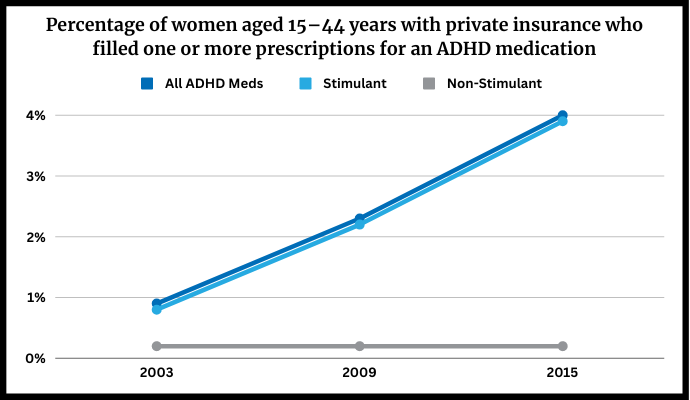America’s Amphetamine Problem, Beyond the Pharmaceutical Supply Chain
Drugs used to treat ADHD have been lacking for months now, leading to problems with access to prescription amphetamines and creating questions about the cause of the massive shortage.

Source: Getty Images
ADHD and Its Treatments
- Attention deficit/hyperactivity disorder (ADHD) is a prevalent mental health condition described as a generalizable inability to pay attention or control impulsive behavior and a tendency to be overactive.
Research has not demonstrated a causal relationship between ADHD and certain risk factors; however, experts are exploring possible causes, including brain injury, heritability, issues during pregnancy and birth, and exposure to environmental hazards at a young age.
Currently, it’s estimated that approximately 13% of boys and 6% of girls living in the United States will develop ADHD at some point. A CDC survey has found that 62% of children take medication to treat their disorder, and 47% receive behavior therapy. Adults can also have ADHD and around 10 million are estimated to be living with the condition today.
ADHD medication includes stimulants like amphetamines and methylphenidate and non-stimulants including atomoxetine, viloxazine, and others. Since their introduction, amphetamines have taken off as the premier treatment for ADHD; specifically, Adderall has become the standard way of dealing with ADHD patients and their behavioral health.
Precipitous Increase in Prescriptions
Adderall and generic brands of ADHD medication are now some of the most commonly prescribed drugs in the US, with more than 41.4 million prescriptions issued in 2020 alone.
At the turn of the millennium, the prescription rate for ADHD medications was still relatively low at around 42.7 per 10,000 persons; however, that rate rapidly increased in the proceeding years, rising to 394.4 per 10,000 persons in 2015. Two factors account for the increase:
- The proportion of children and adults diagnosed with ADHD rose.
- Doctors became more likely to use medication as a primary course of treatment for the disorder.

Source: Xtelligent Healthcare Media, CDC Data
The COVID-19 pandemic also contributed to increased amphetamine prescriptions as more people accessed the drugs through telehealth pharmacies. Since the start of the pandemic lockdowns, stimulant prescriptions for patients aged 22–44 have increased by 15% at least.
Supply Chain Shutdowns and Resource Limitations
Just as prescriptions for Adderall began to skyrocket, COVID-19 was causing massive supply chain issues in the pharmaceutical industry. Many of the major manufacturers of Adderall use a global supply chain to create their drugs which makes them vulnerable to lockdowns and other issues. For instance, Teva Pharmaceuticals, headquartered in Israel, has a portion of manufacturing and R&D capabilities placed in India which had a series of stringent lockdowns in 2020. On top of its three active pharmaceutical ingredient (API) manufacturing facilities, the company has two finished pharmaceutical formulation plants and another two R&D facilities based in the country. Teva also sold more than half a billion dollars worth of Adderall in 2021, making it the largest supplier of the drug to the US market.
As lockdowns and labor shortages left some facilities unable to operate, as seen in the example of China’s contrast agent shutdowns, orders of drugs were sometimes left unfulfilled. At one point in time, seven of the nine US suppliers for Adderall were reporting shortages, including Teva, which remains in shortage in March 2023.
Currently, around 54% of APIs by dollar value are produced in the domestic supply chain, which was minimally affected by COVID-19 lockdowns. But stimulants like Adderall and its generic versions are often produced abroad, making them vulnerable.
Three years on from the beginning of the pandemic, lockdowns have subsided, and their effect on supply chains has largely been curtailed, which raises the question, why are ADHD medications still in shortage?
As of March 2023, persistent shortages reported to the FDA at US Pharma Windlas and Epic Pharma LLC were chalked up to a “shortage of the active ingredient,” while shortages at Alvogen and Teva were due to a “demand increase for the drug.” The two explanations mean the same thing for consumers but indicate that it isn’t just a supply chain failure leading to a lack of ADHD medication.
One official from Sandoz, a company that also supplies Adderall but is listing no shortage, implied that it was not the supply chain causing the supply–demand imbalance in broader markets. Per Bloomberg, that Sandoz official cited the Drug Enforcement Administration’s (DEA) own production quotas as one of the primary constraints on current supplies of ADHD medication. Shire Pharmaceuticals, owned by Japan-based Takeda, also cited the DEA’s policies as leading to a shortage in the US.
Controlled substances like the amphetamine used in Adderall are limited to quotas set by the DEA. If a company wants to increase its quota, it must receive approval from the DEA to increase its supply. If the DEA denies its request, it could limit the amount of ADHD medication available to patients. The Sandoz official claimed that only some of its requests to increase production were approved.
While quotas aren't the only limiting factors on the US ADHD medication supply, it is clear that they have restricted some companies from increasing their output while others fail to provide enough product to fill prescriptions.
The DEA responded to the issue in a statement released on its website. “DEA is committed to ensuring an adequate and uninterrupted supply of controlled substances to meet the estimated legitimate medical, scientific, research, and industrial needs of the US, for lawful export requirements, and for the establishment and maintenance of reserve stocks. DEA sets APQs in a manner to provide for all legitimate medical purposes and for anticipated foreign demand. Additionally, DEA and FDA are required to and routinely do, coordinate efforts to prevent or alleviate drug shortages. Such efforts may include adjusting the APQ, adjusting individual domestic manufacturers' quotas, FDA's approval of additional market competitors, and coordination between the agencies to allow importation of foreign-manufactured drug products that meet FDA approval.”
Failure, Fallout, and Future
The shortfall in ADHD medication supply is due to an irresponsible rise in stimulant prescriptions, a faltering foreign supply chain, and the regulatory prohibition of controlled substances.
The federal government has already firmly planted its foot and begun investigating telehealth prescribers like Cerebral and Done. for their ADHD prescribing practices. Cerebral responded by discontinuing their controlled substance prescriptions while Done. has continued prescribing controlled substances to treat ADHD. The Biden Administration has also proposed a new rule requiring an in-person consultation before any new prescriptions could be issued, which would put a damper on some online prescribing activity. These practices indicate a strong government opposition to the growing use of controlled substances across the US.
With Adderall still in short supply, some patients are forced to switch their prescriptions in a process that can take months to resolve, while others are faced with the prospect of withdrawal, which can bring severe physical side effects.
What remains at the tail end of this supply crisis are more important questions of why the US population has a growing appetite for stimulant prescriptions and whether the government should intervene to abate the growing need for these drugs.
Current market research estimates that the global ADHD therapeutics market will only continue to grow at a substantial pace in the next decades. One forecast expects that the market will reach $45.68 billion by 2027 compared to $29.56 billion in 2022. The rise in adults experiencing ADHD will also be a large contributor to this trend because of their ability to wield more control over their medical treatment and the need for medication-type fixes for a mental disorder that may affect their productivity.
